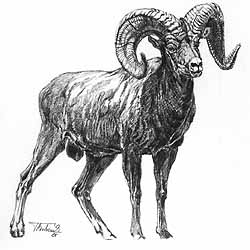English: American Bighorn Sheep; French: Mouflon Bighorn; Algonquin: Manteenesh; Apache: dibetii, bideém biyeshd nechaahi; Chipewyan: bálayttëné; Locheux: divii; Navajo: Tábaastiin; South-Slavey: doo.
 |
Former distribution: From the Canadian Rocky Mountains south to middle-western USA into Colorado, California, Baja California and Mexico.
Present distribution: As formerly, but in restricted areas. Introduced into Spain.
Behaviour: See Alaska Schneeschaf
Population status: Stable.
Estimated numbers (1974) USA: 45 000; Canada: 10 000; Mexico: 5500.
Brief notes: Size and weight decrease from north Canada to south Mexico.
Body weight: 70-140 kg
Head and body length: 175-190 cm
Tail length: 8-12 cm
Shoulder height: 95-110 cm
Gestation period: 175-180 days
Maximum age: 14-17 years
Trophy: Record SCI: 195 2/8 score, 1970 British Columbia, CARL HANSEN jr.; average 155 score. B&C: 208 1/8 score, 1911 Alberta, Canada, FRED WEILLER; average 180 score.
Hunting methods: Stalking.
Subspecies; 7
1. Canadian Bighorn Sheep Ovis c. canadensis From Alberta (Canada) to USA; Montana, South Dakota, Iowa. Rare.
2. Californian Bighorn Sheep Ovis c. californiana Southern British Columbia to Washington, Oregon, Idaho, Nevada. Rare. Trophy: No records.
3. Audubon’s Bighorn Sheep Ovis c. auduboni Missouri, Nebraska, Wyoming. Extinct.
4. Nelson’s Bighorn Sheep Ovis c. nelsoni California, Nevada. Stable. Trophy: Record SCI: 194 3/8 score, 1982 Mexico, Baja California, CLAUDE BOURGUIGNON; average 150 score. B&C: 205 1/8 score, 1940 Mexico, CARL M. SCRIVENS; average 168 score.
5. Mexican Bighorn Sheep Ovis c. mexicana Southern Texas, New Mexico, Arizona; northern Mexico. Endangered. Trophy: see under O.c. nelsoni
6. Sierra San Pedro Bighorn Sheep Ovis c. cremnobates Southern California and northern Baja California in Mexico. Endangered. Trophy: See under O.c. nelsoni
7. Sierra de la Giganta Bighorn Sheep Ovis c. weemsi Southern Baja California, Mexico. Endangered. Trophy: No records.
Remarks: In 1880 the Bighorn Sheep population was about 2 000 000, but due to an increase of domestic livestock, diseases, and uncontrolled hunting, a drastic decline took place. Ovis c. audoboni became extinct in 1916. From 1920 on a management programme reintroduced these sheep into their former ranges in Canada and the USA. Today the Bighorn Sheep is safe again, but it is suggested that hunting permits should be restricted to mature rams – female sheep and young males should be hunted as well. Predators include wolves, cougars, coyotes, lynxes, bobcats, wolverines and eagles. Bighorn Sheep habitats could also be reduced by grazing competition from domestic sheep, cattle and donkeys.





